Unite and Rule: The future of performance poetry in India
Nitika Khaitan
5 August 2015
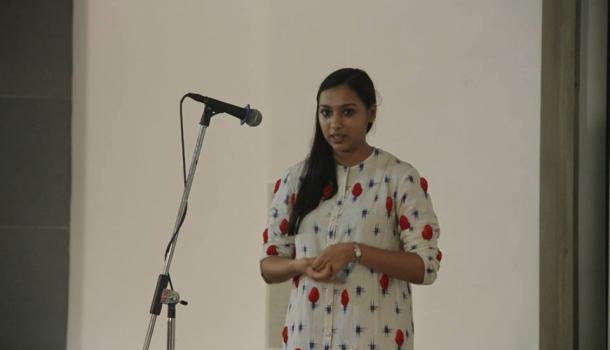
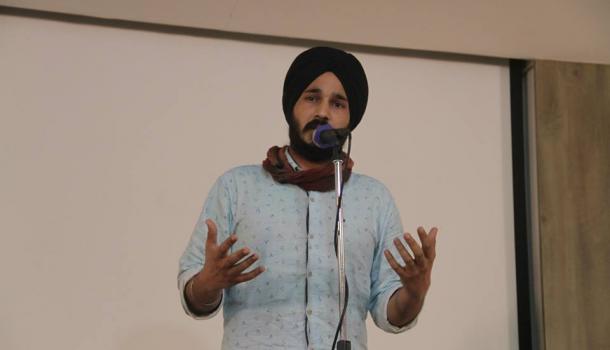
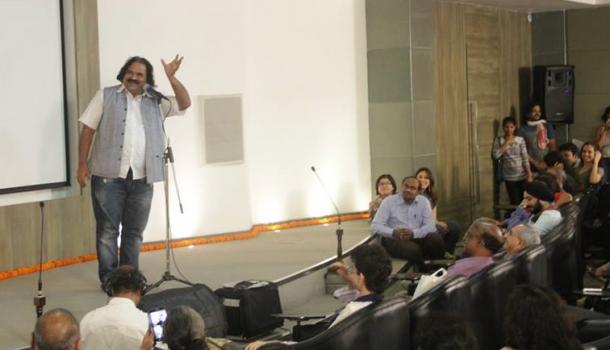
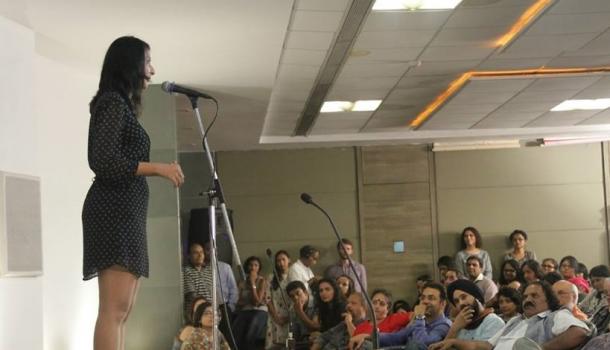

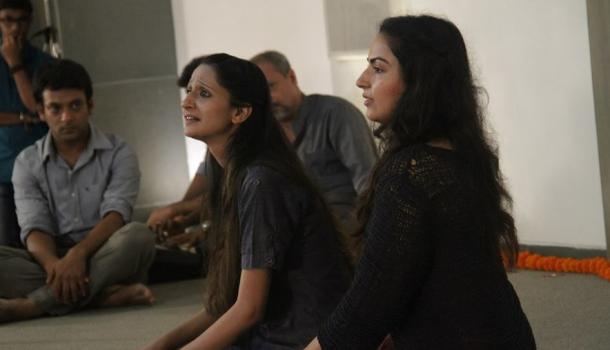
“I’m 65 and I’ve never heard rap before,” an audience member said, addressing the South Dandies Swaraj, a Tamil and English rap crew during the Q&A session after their performance. “But I loved your act and you guys reminded me of Gemini Ganeshan [the yesteryear Tamil film star].” The event was called Me Versus Them: How Mumbai’s Performance Poets Are Breaking Boundaries & Changing Society – a culmination of my summer research on performance poetry in Mumbai with Godrej India Culture Lab, an experimental space that looks to break silos within culture, and serves as a catalyst for conversations around contemporary modern India.
I curated South Dandies Swaraj to be part of a motley crew of performance poets: English spoken word artist Preeti Vangani; Hindustani free verse poet Ramneek Singh, famed Marathi lokshahir Sambhaji Bhagat and experimental troupe Tamaasha Theatre whose play Blank Page blends music, theatre and dance to bring classic Indian poems of various languages to life.
The argument tying all these performers together? That no matter how diverse their forms, or the audiences and locations, all of them are engaged in the tradition of keeping poetry alive, fusing poetry and performance, and striking at the concerns of the contemporary Indian city-dweller. Through my research I realized that the performance poetry scene in India is rich and diverse, but more often than not, artists and audiences in Mumbai are only exposed to a tiny fraction of it. Spoken word fans and artists tend to attend events that cater solely to the art form and the same can be said for rap, and the scores of different genres of folk poets. While no single event can claim to substantively represent the whole performance poetry scene in India, the event we hosted at Godrej India Culture Lab was an attempt to bring together artists across languages and traditions who otherwise might not have shared the same stage together before.
As an undergraduate at Yale where I am currently studying Humanities, I read articles in various newspapers such as The Indian Express, The Sunday Guardian, Times of India among others that documented the rise of spoken word in India. Initially, I wanted to explore performance poetry through spoken word, since that’s how I had come to it. I focused on spoken word events that I had read of and gatherings such as mushairas and sammelans, since their events share many similarities in style and format with spoken word. Unknowingly, I ended up limited my definition of what performance poetry entailed. During the course of my research, I realized that performance poetry in India has historically and continues to occur within traditions that today we might call music or theatre or dance. I therefore had to expand my concept of performance poetry as I continued my research, including traditions that incorporate elements of song, costume, gesture and movement. Mushairas and sammelans were no doubt venerated traditions of performance poetry, having existed in various forms since medieval times. But so were traditions like Marathi shahiri, or ballad-poetry, dating back to the 17th century, which developed primarily through plays, dance and songs.(1) Famous shahirs today like Sambhaji Bhagat draw from an even more diverse set of genres, combining agitprop street theatre and forms such as the powadas.(2)
***
My first brush with differing perceptions among poets of different genres came at a Kavi Sammelan I attended outside Keshav Gore hall in Goregaon a few weeks before Me Verses Them. Ramneek Singh, sitting slouched casually on a plastic chair near the door, scrolling through his poems on his phone, hair tied loosely in a bandana said to me, “I don’t even think these guys will consider what I do poetry."
It was Singh’s first time here. Prodded by a friend, the 26-year old free verse poet, had been performing regularly at open mics that take place in new venues across Mumbai, but he had never been to a traditional Kavi Sammelan.
The program began with poets — television writers, state awardees, hasya kavis—all regulars on the Kavi Sammelan circuit who went up one by one. Some sang geets and others delivered nazms — repeating powerful rhymes to begin, sprinkling puns in between metred couplets, gaining energy from the audience’s vaah-vaahs; then pausing, resting, before they gently return to the refrain, confident they would be met with smiles and badhiyan!’ They spoke of mehengai, imandari, and worlds where Airtel offers sanskaar in the form of recharge vouchers.
When Ramneek went up on stage he spoke of Section 377 in a poem picturing the Constitution lying in a room while a lawyer and poet argue over it. In his next he spoke of his home state Jammu: the words censored, the men killed in accidental firings. He too repeated his beginnings and slowed down for his wordplays: tum se hoon lekin tum sa hona… yeh bhi koi shart thi kya? But unlike the others, his delivery was relentless, one line colliding into the next, emphatic in its resistance to neat sentences and its lack of rhyme.
The response Ramneek received was well over his expectations. The host and senior poets sitting on stage lauded Ramneek for his exciting efforts in chhandmukt poetry, and for being a young person still moved by the finer arts and not just by commercialized programming on television. The other Sammelan poets in the audience walked up to him after the programme and echoed this sentiment in their compliments to Ramneek. They remembered it even in the interviews with me weeks later.
At a spoken word event earlier that week, Ramneek had said to me, “The older generation often tells me my poetry doesn’t flow, that I’m not a poet and I’m doing a disservice to the literary community. Their parameter for poems is ghazals. The younger generation might not appreciate ghazals, but after I perform, they’ll come up to me and tell me, ‘Hum toh hil gaye’. Spoken word gives me the freedom to take my words in my hand and deliver it, jaise kisi ke nason mein daal rahan hoon. It's that powerful.”
I was intrigued by the response Ramneek expected and the one he received and the fact that he called his work ‘spoken word’. Modern spoken word, which Ramneek now identifies with is exemplified in America by artists like Rives and Sarah Kay, and the form can be traced back to American blues music, Beat poets and the Harlem Renaissance.(3) Shantanu Anand of the Airplane Poetry Movement, one of the pioneering platforms for spoken word in the country, also cites Dub poetry in the UK as a precursor of this form. There are obvious similarities in Ramneek’s themes and delivery to spoken word’s hallmark traits. But does he root himself in that tradition, and see his work as reworking the form in another language, or does he feel more connected with free verse poets in Hindustani? Could language, with all its accompanying politics in India, play a role in delineating ‘spoken word’? Or had ‘spoken word’ somehow become the shorthand to describe all contemporary poetry at open mics and poetry readings that had recently boomed in the city, from nazms to multilingual monologues interspersed with songs?
***
The rise of the spoken word scene in Indian cities has been well-documented in English news media, especially since videos like Priyam Redican’s Of Marriageable Age and Rene Verma’s Open Letter to Honey Singh gained lakhs of views on YouTube. These events have been sprouting up in homely cafes, restaurants and pubs across the country, conducted by groups such as The Great Indian Poetry Collective, Delhi Poetry Slam and Mildly Offensive Content among many others. In Mumbai, Bombay Elektrik Projekt is widely acknowledged as one of the scene's pioneers with the monthly open mics it used to hold at Cafe Goa seven years ago. Now, the city seems flush with events: last month alone saw nearly a dozen, including fortnightly open mics at the Hive, Rainbow Mics organized by Queer Ink, Caferati at Prithvi, sessions by The Poetry Club, and workshops by Words Tell Stories.
The language the media often uses to describe this scene is of the 'Facebook generation' finding its voice(4), bringing poetry to the masses through open mics where anyone can perform(5), and using this freeing art form to talk of what bothers young urban India.
But performance poetry in India also encompasses far more varied traditions than these, and holds a broader meaning than what the modern English term usually connotes. To an outsider like me, no matter how different imandari poems at sammelans are from Sambhaji Bhagat’s shahiri and spoken word, they share some fundamental commonalities. They’re all engaged in common projects of exploring the intersection of literature and performance.
Open mics are neither limited to English nor to new age upmarket cafes and they regularly feature ghazals and nazms, which you’ll find both at mushairas and kavi sammelans. However, the cross-pollination is few and far between.
After interviews with many poets, the reason for the divide is not limited to language, form and location, but also with perception. It led me to ask questions such as - what do Mumbai performance poets see themselves as part of, and how do they draw these boundaries? What defines what is “modern” or “traditional" aesthetically? What are perceived differences and what are the real ones? Most importantly, what future do they see for performance poetry in the city? These were a few questions I started asking myself as I started curating the event with Godrej India Culture Lab.
***
L Romal M Singh, a journalist who often performs at the monthly Rainbow Mic at Hive, has a problem with the aesthetic of “contemporary” or “modern” or “cool”, being associated with spoken word. These terms obviously attract more young people and are carelessly used both by the media and in the poets’ own descriptions when categorizing what they do. The features of spoken word they call “modern” and “innovative” include how its growth in India is recent; how its free-flowing form departs from previous forms of blank or rhyming verse; and how it has spread to unprecedented numbers of people across the world, through online modes unique to today.
But what kind of work, then, would be considered "contemporary" and “innovative" in traditions that didn’t grow recently, and that might still be spread mainly through ‘old’ offline modes? Poet Mani Rao offers an insight in her introduction to Innovation in Contemporary Indian Poetry.(6) She says she found that innovation and contemporaneity in the poetry she read for the anthology “was less in the area of style and more in the area of content—a bold lashing out, a quirky view, a bizarre concept or an unusual juxtaposition of ideas.”
Gautam Pemmaraju, a filmmaker who spent a year documenting poetry in Dakhani —a Hyderabadi dialect of Urdu — agrees that he saw poets primarily innovating in content, while preserving the traditional form. He cites the mild contempt you’ll find in Dakhani poetry today for the romantic poetry of the past, and quotes new poetry on unemployment, youth being arrested and satires on religious leaders. As an example he cites a couplet he recently read where the poet goes close to a bomb and examines it, only to find it is saffron and not green.
However, Pemmaraju reiterates Romal’s concern. He notes that poetry in regional languages such as Dakhani has little reach outside of its geographical communities. It’s easy then to encounter stereotypes about the lack of contemporary work and the archaic nature of performance poetry in regional languages. This becomes particularly apparent in urban centres. With a lack of access of contemporary Indian poetry traditions online and the news media’s relatively greater coverage of spoken word as an innovative form, regional poets are mostly ignored.
Many poets at open mics around the city, while lauding efforts to ensure the inclusion of Urdu nazms and Marathi poetry, felt that traditional ghazals or abhangs performed at these mics are still stuck in old romantic tropes of pining away in love that the younger generation can’t relate to. Others felt language, in particular regional languages as compared to English, restrained them from talking about contemporary issues in them. Aditya Joshi, a student at IIT-B, says, “If I say something explicit in Hindi, people feel disgusted. However, if I translate the same sentence into English, people might be okay with it or even laugh at it.” In other words, he feels there is a desire of some sections of society to keep regional languages free of “impure” subjects like sex and sexuality. Aditya wants to write a Marathi shahiri on LGBT issues, but has put off the project for fear of offending Marathi-speakers who think queerness should not be associated with the language.
Whether English provides access to spaces that are more “progressive" or more “cosmopolitan” than vernacular idioms is an age-old debate. Without disregarding the grain of truth that might lie at the heart of this generalization, it is but a stereotype. A new school of Urdu shayari called jadeed shayari, for instance, popularized by the likes of Munawwar Rana, focuses on the social and political issues of the day, in explicit contrast to the romantic shayari that many associate with Urdu. Further, languages like Tamil, Malayalam, and Telugu are known for their “progressive” literature, including issues of gender and sexuality.
None of this is to suggest that only poetry in regional languages is unfairly stereotyped. In a poetry scene as diverse and vast as Mumbai’s where poets are mostly exposed to only a fraction of it, it’s easy for stereotypes to proliferate about all traditions, and for poets to often remain confined to silos, whether they be shahirs or shayars or kavis or spoken word artists.
Ways forward are being suggested by artists who are working across these lines.The music scene is replete with examples of bands taking traditional poems and giving them a contemporary feel with their musical arrangements or singing poetry about current issues in their songs. An exemplar of the former is Neeraj Arya’s Kabir Cafe, a neo-fusion rock band performing Kabir’s poetry. Raman Iyer, the band’s mandolin player notes that this kind of fusion allows them to reach out to a college going crowd who wouldn’t have listened to medieval poetry otherwise, and also allows them to transcend barriers of language. There are others like South Dandies Swaraj who are taking urban poetry, like rap is so often called, and subverting it by writing lyrics in English and Tamil.
Then there is Ramneek, who fuses Hindustani and spoken word delivery styles and wants to perform at more kavi sammelans while he continues his open mic shows; as well as Romal, who combines elements of prose and song in multingual poetry monologues. Artists in genres as diverse as music and theatre are also contributing to breaking down barriers in performance poetry. Noted theatre personality Sunil Shanbag’s current project, co-directed by Sapan Saran and performed by Tamaasha Theatre, is Blank Page – an excerpt of which was performed at the event at the Lab. The play consists of classic Indian poems in English, Hindi, Marathi and Kashmiri, exposing such work to new audiences. They experiment fusing music and movement to present written poetry as a play; and hold performances in bare alternative spaces instead of traditional auditoriums.
The event at Godrej India Culture Lab was a bridge to a few of the divides I found during my research. The selection of performers reflected a slice of the performance poetry scene. We got spoken word artists like Preeti Vangani who represented the urban poetry scene in the city. Ramneek who blends two world, Sambhaji Bhagat who represents contemporary content in folk styles, Tamasha Theatre adding poetry to theatre, and finally South Dandies Squad, who mix music with poetry. Also, the event was an attempt to overcome the barriers that language presents. English was used as a tool to facilitate the event, however the performers during their acts, and the audience during the Q&A section were all multi-lingual using Marathi, English, Tamil and Hindi to communicate.
There are others who are doing important work in bridging gaps such as Ankita Shah, who co-founded The Poetry Club, and Raghavendra Madhu of Poetry Couture. They feel that open mics can help break down language silos—by showing the audience that despite differences in tradition or class, people often perform poems on the same insecurities. More can certainly be done. The impetus for change needs to come from both audiences and artists.
BIBLIOGRAPHY
1. For instance, Marathi shahiri or ballad-poetry, which dates back to the 17th century, developed through plays, dance and songs
Maharashtra Navnirman Sena. "Marathi Poetry." Last accessed 22nd July, 2015. http://web.iiit.ac.in/~sarvesh.ranadeug08/project/Literature.html
2. Lokshahirs like Arun Mhatre and Sambhaji Bhagat draw from agitprop street theatre and powadas
Kappal, Bhanuj. "The Journey of Sambhaji Bhagat." The Caravan, 25th April, 2015. Last accessed 22nd July, 2015. www.caravanmagazine.in/vantage/journey-sambhaji-bhagat-man-who-inspired-making-and-composed-music-film-court
3. Modern spoken word, the kind exemplified by artists like Rives and Sarah Kay, is commonly traced back to blues music, Beat poets and the Harlem Renaissance
Nair, Shreya. "Voices in Your Head." The Indian Express, July 16, 2014. Last accessed 22nd July, 2015. http://indianexpress.com/article/cities/delhi/voices-in-your-head/
4. The language the media often uses to describe this scene is of the 'Facebook generation' finding its voice
Batra, Ruhi. "The performance poets." The Times of India, January 25, 2015. Last accessed 22nd July, 2015.
http://timesofindia.indiatimes.com/home/sunday-times/The-performance-poets/articleshow/46007683.cms
5. bringing poetry to the masses through open mics where anyone can perform
Majumdar, Payel. "The queerious case of spoken word." The Sunday Guardian, 8th November, 2014. Last accessed 22nd July, 2015. http://www.sunday-guardian.com/young-restless/the-queerious-case-of-spoken-word-how-open-mics-in-the-capital-are-bringing-back-poetry
6. Poet Mani Rao offers one answer in her introduction to Innovation in Contemporary Indian Poetry
Rao, Mani. Introduction to "Innovation in Contemporary Indian Poetry". How2 Journal, Vol.2 Issue 4, Spring-Summer 2006. Last accessed 22nd July 2015. https://www.asu.edu/pipercwcenter/how2journal/archive/online_archive/v2_4_2006/current/indian/introduction.html

